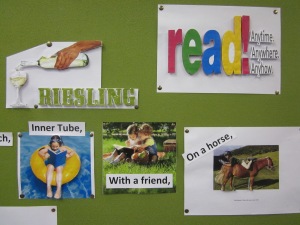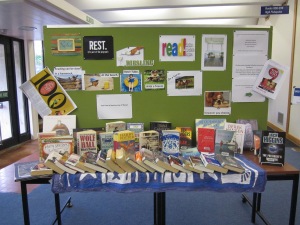The question of measuring the impact of marketing efforts is a fraught one, even in the business world. Check out what Farris et al. have to say on the subject from Marketing Metrics: The Definitive Guide to Measuring Marketing Performance (2nd ed, Pearson Prentice Hall, 2010):
In business and economics, many metrics are complex and difficult to master. Some are highly specialized and best suited to specific analyses. Many require data that may be approximate, incomplete, or unavailable.
Little wonder then that many libraries don’t tackle it – in the US, one study found that less than 33% of academic libraries evaluated their promotional campaigns.
Farris et al. offer this:
Under these circumstances, no single metric is likely to be perfect. For this reason, we recommend that marketers use a portfolio or “dashboard” of metrics. By doing so, they can view market dynamics from various perspectives and arrive at “triangulated” strategies and solutions. Additionally, with multiple metrics, marketers can use each as a check on the others. In this way, they can maximize the accuracy of their knowledge … Being able to “crunch the numbers” is vital to success in marketing. Knowing which numbers to crunch, however, is a skill that develops over time. Toward that end, managers must practice the use of metrics and learn from their mistakes.
Brian Mathews in Marketing today’s academic library: a bold approach to communicating with students (American Library Association, 2009) offers up some of the potential components of that dashboard:
Response-based advertising
For instance getting a customer to visit a website, or take advantage of an offer. The website could be a campaign-specific secondary page to better track statistics.
Market share
This could be calculated by counting the total number of users and dividing them by the total student population. For instance if 4000 students checked out a book at least once during the year out of a total student population of 10,000 then the market share would be 40%. And then we might think about the other 60% who didn’t borrow anything and how to reach them.
How did you hear about us?
This involves inviting students to share their experience. This can be done face to face or by using a follow-up email.
Web analytics
Analyse total hit rates and click-through rates to your website via tools such as Google Analytics.
LibQual+
A customer service survey administered by the Association for Research Libraries (charges apply).
Recall
A technique that can be used in focus groups, surveys or one-to-one interviews.
Dorm (hostel) surveys
Longitudinal studies
This involves tracking student usage over time – how do they find out about our services and how do they use the library over time? Mathews’ example involves selecting 6 new students each year, who he meets with once a semester throughout their degree. He notes this isn’t scientific but it allows him to get a feel for selected user groups and to learn about their experiences.
As Mathew’s says, ultimately there is no silver bullet when it comes to measuring impact and as Farris et al. suggest we need a range of metrics. Critically we also need to remember that this is part of a bigger task – we need to figure out what success would look like – which is all part of the goals we set as to what we want our marketing activities to achieve – right back at the start of the cycle of our marketing activities. For Mathews:
… success, from a marketing standpoint, is a combination of familiarity along with usage, across the span of a student’s tenure. The longevity of library use from day one until graduation is what matters
and
I feel instead of simply focusing on generating awareness or even just increasing use of resources, we should approach communication more philosophically by viewing our marketing as a chance to elevate the role of the library in our students’ minds. In this manner, our advertising encourages them to expect more from us. We are not just providing more books, more journals, more computers, or more staff to help them, but rather more relevance. We should aspire to smash their preconceptions of what a library is and instead demonstrate what it can become.
He proposes the following:
1. List all of the library products and services that are relevant to undergraduates
2. At the end of the academic year ask a random sample of thirty students from different classes and ask them to
a) tick the products and services they have heard of and
b) tick those that they have actually used.
This allows you to track the effectiveness of your communications and the usage of your library.
What tools do you use to measure the impact of your marketing activities?
 I think I fancy a little Riesling with my reading this summer!
I think I fancy a little Riesling with my reading this summer!









